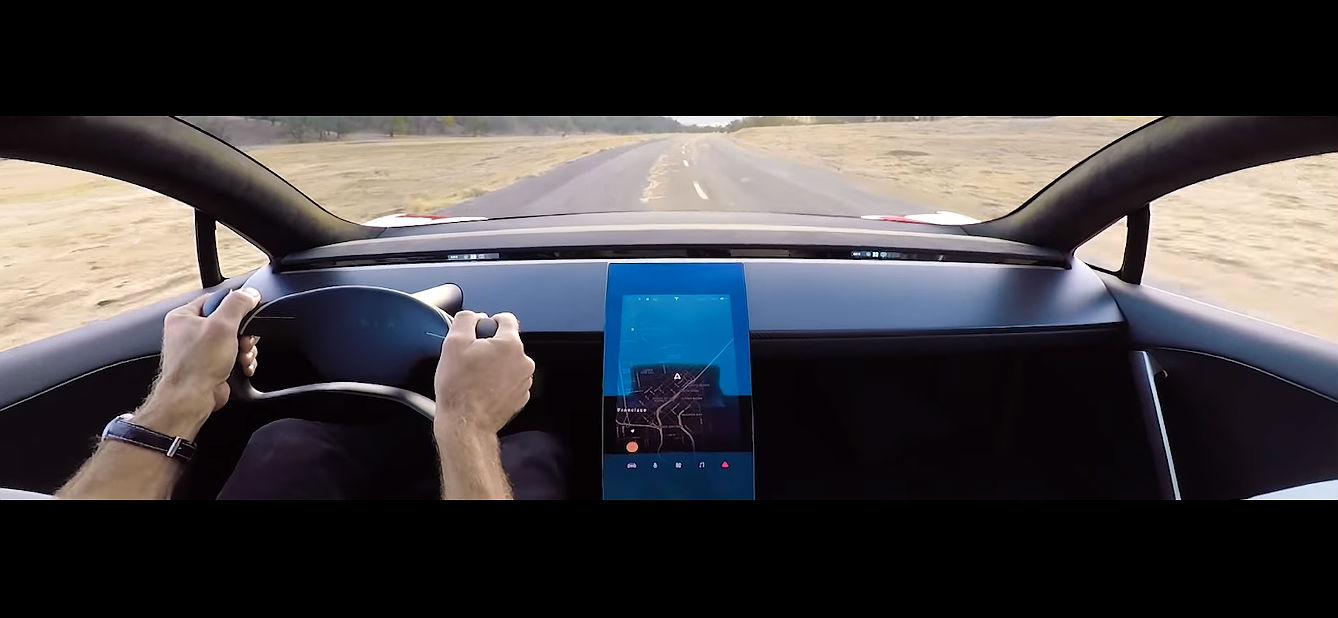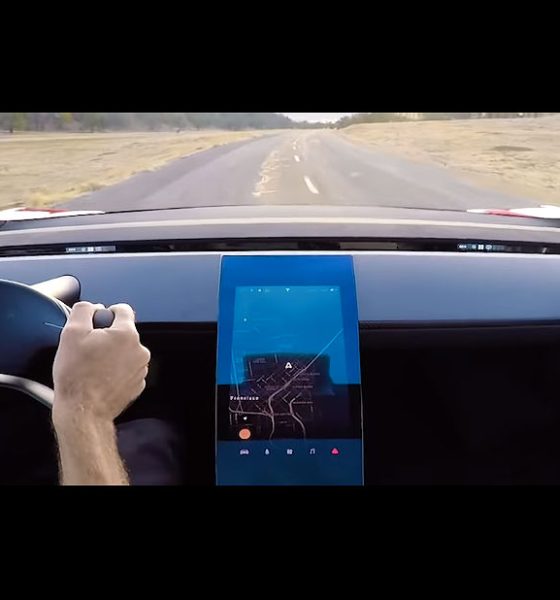

News
Next-gen Tesla Roadster’s “Augmented Mode” will enhance drivers’ abilities
In a recent update on Twitter, Elon Musk revealed that the next-generation Tesla Roadster would feature an “Augmented Mode” that is designed to enhance drivers’ abilities when operating the all-electric supercar.
Musk’s update came as a response to acclaimed YouTube tech reviewer and Tesla owner-enthusiast Marques Brownlee, who inquired if the next-generation Roadster will have Autopilot. Musk promptly responded, confirming the intelligent driver-assist feature and teasing one of the all-electric supercar’s unique capabilities.
Definitely. Will also have Augmented Mode that will massively enhance human driving ability. Like a flying metal suit, but in car form …
— Elon Musk (@elonmusk) June 8, 2018
While Musk’s mention of Augmented Mode and flying metal suits immediately drew references and comparisons to Marvel’s Iron Man and Tony Stark, Tesla has actually been laying the groundwork for integrating augmented reality technology into its electric cars for years. The electric car and energy company, for one, has been amassing talent with experience in the emerging field.
Back in late 2016, Tesla hired Andrew Kim as a Lead Designer at the company’s Design Studio in Hawthorne, CA. Prior to this employment at Tesla, Kim worked for Microsoft, where he helped develop the HoloLens headset, a holographic computer that allows users to see and interact with holograms within an environment.
When Microsoft launched the device back in 2016, the company demoed several uses for the headset, from gaming to holographic conferencing. In the auto industry, Volvo opted to use the HoloLens as a means for potential customers to interact with its vehicles. According to a Trusted Reviews report, the legacy automaker also expects to use the augmented reality technology in its future self-driving car initiatives.
Kim’s LinkedIn profile currently notes that his work at Tesla involves “leading experiences” in Model S, X, 3, Semi, Roadster, and Y, as well as “confidential future products and experiences.” Considering that Tesla’s vehicles are known for being on the bleeding edge of automotive technology, it is not difficult to speculate that the next-generation Roadster’s Augmented Mode could involve the incorporation of holographic images that can provide information such as suggested routes, driving tips, and safety warnings to drivers when operating the vehicle, similar to the technology showcased by Hyundai during CES 2015.
Augmented features are actually a perfect match to the all-electric supercar’s interior design. As could be seen in the prototype unveiled last November and the company’s quarterly all-hands promo video, the next-generation Roadster’s dashboard is almost just as, if not more minimalistic, than the Model 3. If any, the next-gen Roadster’s sparse dashboard provides ample space for Tesla to incorporate augmented reality technology.

A white next-gen Tesla Roadster makes an appearance during the 2018 annual shareholders meeting. [Credit: Dennis Pascual/Twitter]
The next-gen Tesla Roadster is nothing short of a beast. The all-electric supercar’s base variant, for one, already breaks several records, with a 0-60 mph time of 1.9 seconds, a quarter-mile time of 8.9 seconds, 10,000 Nm of torque, a range of 620 miles thanks to a 200 kWh battery, and a top speed of more than 250 mph. During Tesla’s 2018 Annual Shareholder Meeting, Musk announced that a SpaceX option would be available for the next-gen Roadster, which would push the capabilities of the electric car even further.
Considering the raw power of the upcoming all-electric supercar, there will only be very few drivers who could properly operate the next-gen Roadster to its full potential. Pushing a car with a top speed of more than 250 mph and a 0-60 mph time of 1.9 seconds at its base trim, after all, requires skill and reflexes that the average driver simply does not have, or at least was not trained to hone. Thus, features such as Augmented Mode would likely be a welcome feature for many future owners of the next-generation Roadster.
Tesla is steadily increasing its marketing efforts for the next-generation Roadster. During the Tesla’s 2018 Annual Shareholder Meeting, a stunning white variant of the all-electric supercar was unveiled. Last month, Elon Musk also announced that test drives for the vehicle would begin sometime near the end of next year.
Here’s a demonstration of Hyundai’s use of augmented reality technology for its vehicles in CES 2015.

News
Tesla (TSLA) receives “Buy” rating and $551 PT from Canaccord Genuity
He also maintained a “Buy” rating for TSLA stock over the company’s improving long-term outlook, which is driven by autonomy and robotics.

Canaccord Genuity analyst George Gianarikas raised his Tesla (NASDAQ:TSLA) price target from $482 to $551. He also maintained a “Buy” rating for TSLA stock over the company’s improving long-term outlook, which is driven by autonomy and robotics.
The analyst’s updated note
Gianarikas lowered his 4Q25 delivery estimates but pointed to several positive factors in the Tesla story. He noted that EV adoption in emerging markets is gaining pace, and progress in FSD and the Robotaxi rollout in 2026 represent major upside drivers. Further progress in the Optimus program next year could also add more momentum for the electric vehicle maker.
“Overall, yes, 4Q25 delivery expectations are being revised lower. However, the reset in the US EV market is laying the groundwork for a more durable and attractive long-term demand environment.
“At the same time, EV penetration in emerging markets is accelerating, reinforcing Tesla’s potential multi‑year growth runway beyond the US. Global progress in FSD and the anticipated rollout of a larger robotaxi fleet in 2026 are increasingly important components of the Tesla equity story and could provide sentiment tailwinds,” the analyst wrote.
Tesla’s busy 2026
The upcoming year would be a busy one for Tesla, considering the company’s plans and targets. The autonomous two-seat Cybercab has been confirmed to start production sometime in Q2 2026, as per Elon Musk during the 2025 Annual Shareholder Meeting.
Apart from this, Tesla is also expected to unveil the next-generation Roadster on April 1, 2026. Tesla is also expected to start high-volume production of the Tesla Semi in Nevada next year.
Apart from vehicle launches, Tesla has expressed its intentions to significantly ramp the rollout of FSD to several regions worldwide, such as Europe. Plans are also underway to launch more Robotaxi networks in several more key areas across the United States.
News
Waymo sues Santa Monica over order to halt overnight charging sessions
In its complaint, Waymo argued that its self-driving cars’ operations do not constitute a public nuisance, and compliance with the city’s order would cause the company irreparable harm.

Waymo has filed a lawsuit against the City of Santa Monica in Los Angeles County Superior Court, seeking to block an order that requires the company to cease overnight charging at two facilities.
In its complaint, Waymo argued that its self-driving cars’ operations do not constitute a public nuisance, and compliance with the city’s order would cause the company irreparable harm.
Nuisance claims
As noted in a report from the Los Angeles Times, Waymo’s two charging sites at Euclid Street and Broadway have operated for about a year, supporting the company’s growing fleet with round-the-clock activity. Unfortunately, this has also resulted in residents in the area reportedly being unable to sleep due to incessant beeping from self-driving taxis that are moving in and out of the charging stations around the clock.
Frustrated residents have protested against the Waymos by blocking the vehicles’ paths, placing cones, and “stacking” cars to create backups. This has also resulted in multiple calls to the police.
Last month, the city issued an order to Waymo and its charging partner, Voltera, to cease overnight operations at the charging locations, stating that the self-driving vehicles’ activities at night were a public nuisance. A December 15 meeting yielded no agreement on mitigations like software rerouting. Waymo proposed changes, but the city reportedly insisted that nothing would satisfy the irate residents.
“We are disappointed that the City has chosen an adversarial path over a collaborative one. The City’s position has been to insist that no actions taken or proposed by Waymo would satisfy the complaining neighbors and therefore must be deemed insufficient,” a Waymo spokesperson stated.
Waymo pushes back
In its legal complaint, Waymo stated that its “activities at the Broadway Facilities do not constitute a public nuisance.” The company also noted that it “faces imminent and irreparable harm to its operations, employees, and customers” from the city’s order. The suit also stated that the city was fully aware that the Voltera charging sites would be operating around the clock to support Waymo’s self-driving taxis.
The company highlighted over one million trips in Santa Monica since launch, with more than 50,000 rides starting or ending there in November alone. Waymo also criticized the city for adopting a contentious strategy against businesses.
“The City of Santa Monica’s recent actions are inconsistent with its stated goal of attracting investment. At a time when the City faces a serious fiscal crisis, officials are choosing to obstruct properly permitted investment rather than fostering a ‘ready for business’ environment,” Waymo stated.
News
Tesla FSD v14.2.2 is getting rave reviews from drivers
So far, early testers have reported buttery-smooth drives with confident performance, even at night or on twisty roads.

Tesla Full Self-Driving (Supervised) v14.2.2 is receiving positive reviews from owners, with several drivers praising the build’s lack of hesitation during lane changes and its smoother decision-making, among others.
The update, which started rolling out on Monday, also adds features like dynamic arrival pin adjustment. So far, early testers have reported buttery-smooth drives with confident performance, even at night or on twisty roads.
Owners highlight major improvements
Longtime Tesla owner and FSD user @BLKMDL3 shared a detailed 10-hour impression of FSD v14.2.2, noting that the system exhibited “zero lane change hesitation” and “extremely refined” lane choices. He praised Mad Max mode’s performance, stellar parking in locations including ticket dispensers, and impressive canyon runs even in dark conditions.
Fellow FSD user Dan Burkland reported an hour of FSD v14.2.2’s nighttime driving with “zero hesitations” and “buttery smooth” confidence reminiscent of Robotaxi rides in areas such as Austin, Texas. Veteran FSD user Whole Mars Catalog also demonstrated voice navigation via Grok, while Tesla owner Devin Olsen completed a nearly two-hour drive with FSD v14.2.2 in heavy traffic and rain with strong performance.
Closer to unsupervised
FSD has been receiving rave reviews, even from Tesla’s competitors. Xpeng CEO He Xiaopeng, for one, offered fresh praise for FSD v14.2 after visiting Silicon Valley. Following extended test drives of Tesla vehicles running the latest FSD software, He stated that the system has made major strides, reinforcing his view that Tesla’s approach to autonomy is indeed the proper path towards autonomy.
According to He, Tesla’s FSD has evolved from a smooth Level 2 advanced driver assistance system into what he described as a “near-Level 4” experience in terms of capabilities. While acknowledging that areas of improvement are still present, the Xpeng CEO stated that FSD’s current iteration significantly surpasses last year’s capabilities. He also reiterated his belief that Tesla’s strategy of using the same autonomous software and hardware architecture across private vehicles and robotaxis is the right long-term approach, as it would allow users to bypass intermediate autonomy stages and move closer to Level 4 functionality.








